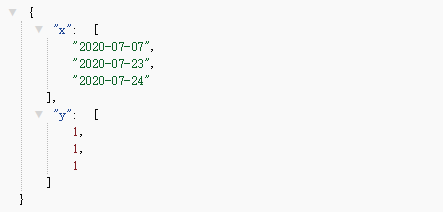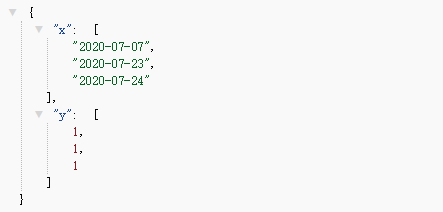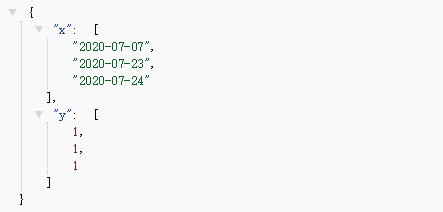django查询今天,昨天,一周,分组统计月,年
发布时间:2020-08-13 13:23:27编辑:admin阅读(3469)
一、概述
有一个用户表,models.py内容如下:
from django.db import models
# Create your models here.
class User(models.Model): #用户名表
username = models.CharField(max_length=16,verbose_name="用户名")
password = models.CharField(max_length=32,verbose_name="密码")
create_time = models.DateTimeField(auto_now_add=True,verbose_name="创建时间")
last_time = models.DateTimeField(verbose_name="登录时间")
class Meta:
# 多列唯一索引
unique_together = ('username','create_time')
本文用的是sqlite3数据库,插入初始数据,insert语句如下:
INSERT INTO "main"."application_user" ("id", "username", "password", "create_time", "last_time", "ROWID") VALUES (1, 'xiao1', 1234, '2020-01-01 13:14:52', '2020-01-01 13:14:52', 1);
INSERT INTO "main"."application_user" ("id", "username", "password", "create_time", "last_time", "ROWID") VALUES (2, 'xiao2', 1234, '2020-02-02 13:14:52', '2020-02-02 13:14:52', 2);
INSERT INTO "main"."application_user" ("id", "username", "password", "create_time", "last_time", "ROWID") VALUES (3, 'xiao3', 1234, '2020-03-03 13:14:52', '2020-03-03 13:14:52', 3);
INSERT INTO "main"."application_user" ("id", "username", "password", "create_time", "last_time", "ROWID") VALUES (4, 'xiao4', 1234, '2020-04-04 13:14:52', '2020-04-04 13:14:52', 4);
INSERT INTO "main"."application_user" ("id", "username", "password", "create_time", "last_time", "ROWID") VALUES (5, 'xiao5', 1234, '2020-05-05 13:14:52', '2020-05-05 13:14:52', 5);
INSERT INTO "main"."application_user" ("id", "username", "password", "create_time", "last_time", "ROWID") VALUES (6, 'xiao6', 1234, '2020-06-06 13:14:52', '2020-06-06 13:14:52', 6);
INSERT INTO "main"."application_user" ("id", "username", "password", "create_time", "last_time", "ROWID") VALUES (7, 'xiao7', 1234, '2020-07-07 13:14:52', '2020-07-07 13:14:52', 7);
INSERT INTO "main"."application_user" ("id", "username", "password", "create_time", "last_time", "ROWID") VALUES (8, 'xiao8', 1234, '2020-07-23 13:14:52', '2020-07-22 13:14:52', 8);
INSERT INTO "main"."application_user" ("id", "username", "password", "create_time", "last_time", "ROWID") VALUES (9, 'xiao9', 1234, '2020-07-24 13:14:52', '2020-07-22 13:14:52', 9);
需求如下:
1. 查询今天,昨天,一周的用户数。
2. 最近一个月,分组统计每一天的数量
3. 最近1年,分组统计每一个月的数量
二、项目演示
新建一个项目,名字为:test_rom,应用名称为:application
django版本为:3.0.8
settings.py
修改时区,内容如下:
TIME_ZONE = 'Asia/Shanghai' USE_I18N = True USE_L10N = True USE_TZ = False
urls.py
from django.contrib import admin
from django.urls import path
from application import views
urlpatterns = [
path('admin/', admin.site.urls),
path('index/', views.index),
path('month/', views.month),
path('year/', views.year),
]
views.py
from django.shortcuts import render
import datetime
from application import models
from django.http import JsonResponse
import time
from dateutil.relativedelta import relativedelta
from django.db.models.functions import TruncMonth,TruncYear,ExtractYear,ExtractMonth
from django.db.models import Count
from django.db import connection
# Create your views here.
def index(request):
# 今日###############
today = datetime.datetime.now().date()
ret = models.User.objects.filter(create_time__gte=str(today) + ' 00:00:00')
today_len = len(ret)
# 昨天###############
yesterday = (datetime.datetime.now() + datetime.timedelta(days=-1)).date()
ret = models.User.objects.filter(create_time__gte=str(yesterday) + ' 00:00:00',
create_time__lte=str(today) + ' 23:59:59')
yesterday_len = len(ret)
# 一周前
today = datetime.datetime.now().date()
weekdelta = datetime.datetime.now().date() - datetime.timedelta(weeks=1)
ret = models.User.objects.filter(create_time__gte=str(weekdelta) + ' 00:00:00',
create_time__lte=str(today) + ' 23:59:59')
week_len = len(ret)
# 总数量
ret = models.User.objects.all()
total_len = len(ret)
data = {
"today": today_len,
"yesterday": yesterday_len,
"week": week_len,
"total": total_len
}
return JsonResponse(data)
def month(request):
# 当前年,月
this_year = time.strftime("%Y", time.localtime(time.time()))
this_month = time.strftime("%m", time.localtime(time.time()))
# 按天分组
select = {'day': connection.ops.date_trunc_sql('day', 'create_time')}
count_data = models.User.objects.filter(create_time__year=this_year, create_time__month=this_month).extra(
select=select).values('day').annotate(number=Count('id'))
x_list = []
y_list = []
for i in count_data:
x_list.append(i['day'])
y_list.append(i['number'])
data = {"x": x_list, "y": y_list}
return JsonResponse(data)
def year(request):
# 计算时间
time_ago = datetime.datetime.now() - relativedelta(years=1)
# print("time_ago",time_ago)
# 获取近一年数据
one_year_data = models.User.objects.filter(create_time__gte=time_ago)
# 分组统计每个月的数据
count_res = one_year_data \
.annotate(year=ExtractYear('create_time'), month=ExtractMonth('create_time')) \
.values('year', 'month').order_by('year', 'month').annotate(count=Count('id'))
# 封装数据格式
month_list = []
count_list = []
for i in count_res:
month_list.append("%s-%s" % (i['year'], i['month']))
count_list.append(i["count"])
data = {"month": month_list, "count": count_list}
return JsonResponse(data)
启动并访问
使用Pycharm直接启动即可,访问首页:
http://127.0.0.1:8001/index/
效果如下:

访问最近一个月分组数据
http://127.0.0.1:8001/month/
效果如下:

访问最近一年的分组数据
http://127.0.0.1:8001/year/
效果如下:

下一篇: 基于docker搭建gitlab
- openvpn linux客户端使用
51784
- H3C基本命令大全
51474
- openvpn windows客户端使用
41875
- H3C IRF原理及 配置
38651
- Python exit()函数
33143
- openvpn mac客户端使用
30130
- python全系列官方中文文档
28807
- python 获取网卡实时流量
23798
- 1.常用turtle功能函数
23713
- python 获取Linux和Windows硬件信息
22081
- Ubuntu本地部署dots.ocr
142°
- Python搭建一个RAG系统(分片/检索/召回/重排序/生成)
2312°
- Browser-use:智能浏览器自动化(Web-Agent)
3004°
- 使用 LangChain 实现本地 Agent
2508°
- 使用 LangChain 构建本地 RAG 应用
2456°
- 使用LLaMA-Factory微调大模型的function calling能力
3080°
- 复现一个简单Agent系统
2459°
- LLaMA Factory-Lora微调实现声控语音多轮问答对话-1
3277°
- LLaMA Factory微调后的模型合并导出和部署-4
5394°
- LLaMA Factory微调模型的各种参数怎么设置-3
5212°
- 姓名:Run
- 职业:谜
- 邮箱:383697894@qq.com
- 定位:上海 · 松江
